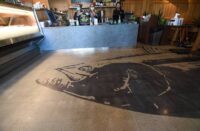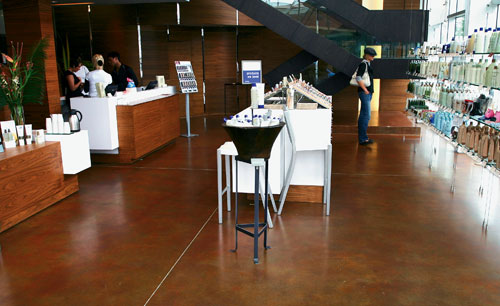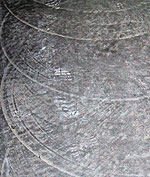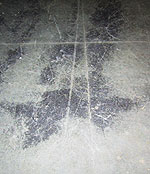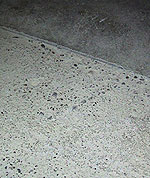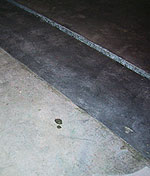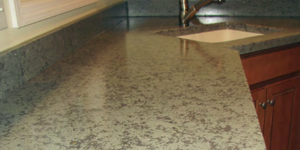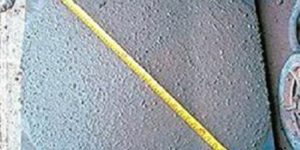Mix Design – What do those two words conjure up in our imagination? Architects randomly pulling ingredients off a shelf? Engineers wanting to prove they have the perfect solution? Owners going overboard in their expectations? Ready mix operators using what they have in their silos?
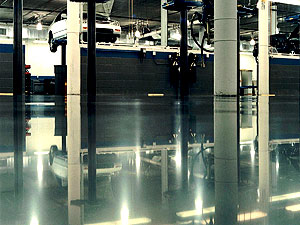
Mix design should be looked at as the foundation for successfully marrying design and performance expectations. And what are the most important ingredients of mix design? Education and communication!
Polished concrete brings many new equations to the table when it is specified. First, but often overlooked, is exactly where it should be placed in the specifications. What is polished concrete? Is it part of the Construction Specification Institute’s (CSI) 2004 Master Format of Division 3 for Concrete, or is it part of Division 9 Special Finishes, or is it both?
During my years as a Certified Applicator for RetroPlate, we tended to take the shotgun approach and hit both divisions, but too often people use only Division 9 and the specification becomes an ” I didn’t budget for that” item. Today, in my position as marketing director for RetroPlate, I have far greater interaction with both specification professionals in architectural firms and quality-control experts in the ready mix industry, and it appears as though Division 3 is the clear winner
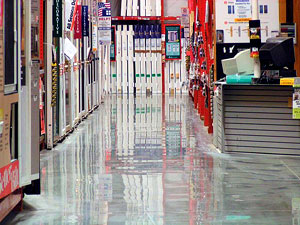
Fred Herbold, CSS, CSI with SERA Architects in Portland, Ore., says he sees polished concrete as part of the placement criteria and feels that the opportunity for bidders to miss the specification is too easy if placed in Division 9. And from the ready mix side, Tony Allison, Glacier Northwest’s head of quality control in Portland, notes the importance of knowing the end use and expectations while designing the mix. As he pointed out to me, the types of materials that are readily available locally will affect the components of the mix as well as what percentage of each component (sand, aggregate, cement, water, additives) is necessary to deliver the expected results. For example, in the 250 miles between Seattle and Eugene, Ore., the different types of naturally occurring aggregate can change the necessary cement requirements three times. If you’re an engineer located in Pittsburg who is designing a mix to be poured in Portland, don’t make the assumption that the aggregate will be the same. Instead, assume that it won’t be. Local knowledge translates into greater success, along with better cost control.
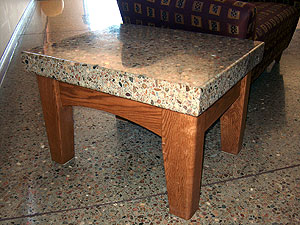
Do’s and don’ts of mix design for polished concrete:
Do not!
- Do not use calcium chloride accelerators, as they can interfere with acid stains and densifiers.
- Do not use air entrainment, or at least hold to a maximum of 3 percent. Your finish will not be as tight or reflective (air will not polish), and air-entrained concrete has lower compressive strength. For every 1 percent increase in air, the compressive strength decreases by 5 percent.
- Polymer-based overlayments should be avoided, as they do not chemically react with densifiers in the same manner as standard portland cement.
- Do not use topical curing agents that will act as a barrier to densifier penetration. Even products that claim to be “UV dissipative and break down under traffic,” can come back to haunt you when it comes time to perform your work.
Be aware:
- Be aware of changes in the water/cement ratio. This can alter the strength of the concrete, along with the ability to achieve an optimum finish.
- Be aware that integrally colored concrete tends to have lower compressive strength, along with taking longer to hydrate.
- Be aware, when specifying an exposed aggregate finish, not to use volcanics as part of your aggregate mix, as they are prone to “pop-outs.”
- When specifying an aggregate, know the maximum aggregate size that your local ready mix operator can pump.
- It’s good to be “green,” but be smart when specifying pozzolan additions — hold them to 20 percent of your cement weight. During hydration, cement creates the calcium hydroxide with which the densifier reacts, so you need to control the substitution amounts. Note: Fly ash is categorized as either Class C or Class F. Class C has it’s own cementitious properties, but Class F does not. It is important to know that you have very little control over which type of fly ash you will receive, so err on the side of caution.
- Lastly, don’t shortchange the curing process. It is during the curing process that the calcium hydroxide is formed, and it is the calcium hydroxide that chemically reacts with the densifier to tighten and strengthen the floor. For long wearing surface, proper curing is a must.
Steps to success:
- Do use sound aggregate for exposed aggregate floors. Sound, dense aggregate will polish and hold its shine better.
- Do communicate F(f) and F(l) requirements with your ready mix operator so that they can make adjustments for proper finishing time.
- Do talk about finishing requirements — hand trowel, power trowel, metal or plastic blades, curing procedures.
- Do not assume that you know what the customer’s expectations are — qualify them up front. Are they “buying” a specific polish level, mix color or aggregate type? Educate your general contractor, ready mix operator and finisher as to exactly what you and your customers’ expectations are.
- Know that there is a definite correlation between cracking and the percentage of cement specified in the mix. The smaller the aggregate size, the more cement paste that is required to surround and hold the mix together. With larger-aggregate mixes, your shrinkage and cracking will be reduced. Talk with your mix design experts to ensure that you get both the performance and appearance you require on your project.
- Educate the owner and specifier about the natural variations in concrete and its ingredients.
- Educate the specifier on the variations of materials in different geographic regions.
- Educate all parties on the cost of specifying particular aggregate, sand, and cement. Shipping costs can be prohibitive.
- Convene a pre-pour meeting before it is too late or costly to fix a problem that arises out of poor communication.
- Are the materials available?
- Are there special equipment requirements?
- Is the product or methodology proprietary?
- Are there trained and certified contractors available with the required expertise and experience?
- Are there regional issues that can affect the timeline or the floor? Has everyone been educated on the potential for carbonization in cold climates? Are there any steps in the process that require controlled humidity?
- State the obvious — do not assume.
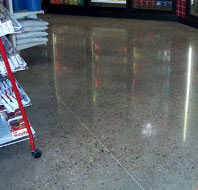
Placement
The flatwork contractor needs to be in on the ground floor. They need to know that a dry shake floor requires plastic blades. They need to know not to burn the floor or ride the power trowel dry. They need to know that any change in technique, amount of water or change in weather can affect the final appearance, or even the ability to provide a polished floor to meet the customer’s expectations.
Curing
Improper curing of the floor can defeat proper mix design and placement.
- The best cure is a water cure. It minimizes edge and joint curling that can occur by uneven curing. Grinding curled edges and joints will always expose aggregate, even if the rest of the floor is flat and has only the cream polished.
- Topical curing agents will create a bond barrier to the densifier, dyes or acid stains. Even dissipative products break down unevenly, as UV exposure and traffic are not consistent. To play it safe, grinding deeply with metals is the only true way to remove these products.
- It is during the curing process that the calcium hydroxide is formed with which your densifier will react and create the densification.

Protection
The method in which the slab is protected is especially important as it can create permanent blemishes in the slab.
- Do not put down wood products that can leach tannins into the slab.
- Any product that can put uneven and/or irregular pressure on the slab can cause a “shading” appearance as the area cures differently.
- Wrinkled plastic sheeting can create a “leathery” appearance.
- Untaped seams will promote an outline pattern of the material used to protect the slab. i.e., a 4-foot x 8-foot sheet of hard board.
Look into some of the new curing products that are manmade, such as UltraCure at www.UltraCure.net. But still remember to tape the seams. Products like this are biodegradable and may be taken to the landfill. After the work is finished, EZcover, by the same company, provides a good, breathable cover with a soft side to lay against the floor, and a harder top layer to shield against contaminants and impacts.
Note: In the event that you are required to perform your work earlier in the construction process than normal, remember that a fully densified floor will stand up better to the abuse of construction.
The most basic ingredient to success is continually educating yourself, and then communicating with all your partners on the project. To be the best, and to deliver the best, you need to communicate — and put to rest your mistrust in sharing your knowledge.


